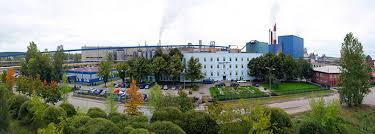Papercut: Climate Change’s Impact on the Pulp & Paper Industry

The pulp and paper industry raises environmental concerns on multiple fronts: wood pulp from trees is required as an input to the paper-making process, and the paper production process itself is highly energy-intensive. In the face of climate change, how can industry giants like International Paper respond?
International Paper is $22.4B pulp and paper manufacturer based in Memphis, TN that operates across the paper production value chain [1]. The paper-making process begins with the production of pulp from harvested trees or recycled paper. Pulp is mixed with water, cleaned, and treated in preparation for the web formation step, where the wet pulp is stretched onto a screen in a web-like sheet. This pulp-based sheet is dried and stretched as it travels down a heated production line, after which it is coiled into rolls that can weigh over 20 tonnes. These paper rolls can also undergo finishing, or ‘converting,’ steps, such as trimming or applying coatings [2].
Exhibit 1: Papermaking Production Process [3]
International Paper produces both pulp that it uses as an input and a range of finished paper products, such as containerboard for corrugated boxes, printing paper for books and envelopes, and consumer packaging for food items and pharmaceuticals. Although International Paper is a brand that many consumers may not recognize, its products are sold under names like Hammermill and Postmark that have higher brand awareness. It has enormous scale, managing over 300,000 acres of forestland in Brazil and operating 24 pulp and paper mills, 169 packaging plants, and 16 recycling plants [1].
The paper industry is facing environmental pressure on multiple dimensions, especially in light of global concerns over climate change, and International Paper is no exception. The paper production process requires a large amount of energy, with paper and pulp ranked fifth among industries in terms of its energy consumption [4]. This process generates a high level of carbon dioxide emissions, with paper and pulp contributing 9% of all manufacturing CO2 emissions [5]. It also can lead to runoff pollution of water sources, filling of landfills, and deforestation.
The increasing regulations enacted in response to climate change have presented challenges for International Paper and other players in the paper industry. These can be seen most explicitly in efforts to reduce GHG emissions. The 2015 COP21, a successor to the 1997 Kyoto Protocol, established non-binding emission reduction targets for many countries, including the US. Under COP21, the US made a non-binding commitment to reduce GHG emissions by 26-28% by 2025 compared to 2005 emissions [1]. The EU founded an Emissions Trading System, which impacts two of International Paper’s sites in Poland and France. Within the United States, the EPA enacted the Clean Power Plan to require the development of plans in the next three years to reduce pollutants from Electrical-Generating Units (EGUs) by 32% by 2022-2033 compared to 2005 levels [1]. Beyond regulations on GHG emissions, rising awareness of climate change has also brought on increasing public attention to contributions to landfills and deforestation, as both tend to exacerbate rising GHG levels, as well as water usage and pollution.
International Paper is currently taking steps to comply with new regulations, which it publishes in an annual sustainability report. As of 2014, it had reduced GHG emissions by 8.3% compared to 2010, which is ~40% of its goal of 20% reduction by 2020 [6]. It had reduced manufacturing waste sent to landfills by 17% compared to 2010 levels, which is over halfway to its goal of a 30% reduction [6]. International Paper is also currently undergoing activities to increase recycling and assess how to improve water usage.
The progress made to date by International Paper is promising, although its 2020 goals do not map precisely to the COP21 commitments and are primarily reactionary in the face of current and anticipated regulations. Based on its current achievements, International Paper should use learnings from some of its successful improvements, such as the 30% reduction in its Louisiana plant’s natural gas usage achieved by upgrading equipment, and apply them more broadly across production sites [6]. It could also experiment with innovative approaches, such as the biochemical process designed by the Confederation of European Paper Industries in 2013 with the potential to reduce energy usage by 40% via updates to the papermaking process’s web formation stage [4]. From a forestry perspective, it could increase its share of recycled wood pulp and ensure that its sources comply with sustainable forest management. Technology upgrades can be challenging to justify in an industry with decreasing demand and large, long-lasting fixed assets, but upgrades have the potential to improve International Paper’s energy usage and positioning with customers as a sustainable supplier.
Whether or not International Paper will take the opportunity to become a more sustainable paper provider remains to be seen – but the potential to do so exists.
[Word count: 766]
[1] International Paper, 2015 Annual Report, [http://s1.q4cdn.com/597881801/files/doc_financials/2015/IPA0007_04192016_10K-FINALONLINE_with-10K-Form.pdf], accessed October 2016.
[2] “How Paper is Made,” WIPaperCouncil.org, 2016, [http://wipapercouncil.org/about-paper/how-paper-is-made/], accessed November 2016.
[3] Andrews, Kevin, “Leveraging Paper Making Machinery for New Product Applications,” November 21, 2014, [https://ninesights.ninesigma.com/rfps/-/rfp-portlet/rfpViewer/2645], accessed November 2016.
[4] “Roll on the Green Revolution,” Economist.com, November 30, 2013, [http://www.economist.com/news/business/21590965-technological-fix-proposed-combat-global-warming-roll-green-revolution], accessed November 2016.
[5] “Impacts on Climate,” GreenPressInitiative.org, 2007, [http://www.greenpressinitiative.org/impacts/climateimpacts.htm], accessed November 2016.
[6] International Paper, “In Our Nature: Sustainability Year in Review 2014,” [http://www.internationalpaper.com/docs/default-source/english/sustainability/reportlayout-yironly-web.pdf?sfvrsn=2], accessed October 2016.




Indeed the paper industry faces some challenges from climate changes well outlined in the post, mainly around energy sources and water.
However I also believe climate change can provide significant opportunities to the paper & forestry industry, the main one built around renewability. Paper wins against plastic everytime at the climate game.
Currently the industry is split between the attractive growthful packaging branch pushed by e-commerce and the disappearing dying publishing branch threaten by digitalization. All of us get more and more used to received our parcels in Amazon familiar corrugated board boxes but we also get less fond of printed paper or fliers in our physical mailboxes.
And the industry will not let go that chance to make it up for the decrease of print communication!
Stora Enso outlines well the main benefit that could arise from climate change in its annual and sustainability reports:
– Higher forestry productivity from increase in average temperatures, precipitation, and CO2 levels
– More biomass energy generation which is an excellent way of valorizing recycled pulp & fiber and old newspaper
– Innovation with more fiber & pulp renewable products in our everyday life, including food container, light furniture, etc.
Stora Enso assessment of risk & opportunities: http://assets.storaenso.com/se/com/DownloadCenterDocuments/SE_responsibility_risks_and_opportunities_due_the_climate_change.pdf
Ellen: I really enjoyed reading your post – I originally expected this all to be about deforestation but it was interesting to learn how much energy the actual manufacturing process consumes. I think you laid out some good, actionable recommendations, but my cynical question is: can paper companies afford to implement these changes at this point? I have to imagine that climate change concerns are also creating a squeeze from below, whereby customers are ordering less paper and sales are declining. In one article, analysts predicted that demand for paper will fall another 18% by 2024: http://www.startribune.com/nov-18-2012-as-society-sheds-paper-an-industry-shrinks/179601951/
I know there will always be some demand for paper, and someone has got to make it, but if I was in the paper industry at this time I would be looking for the exit.